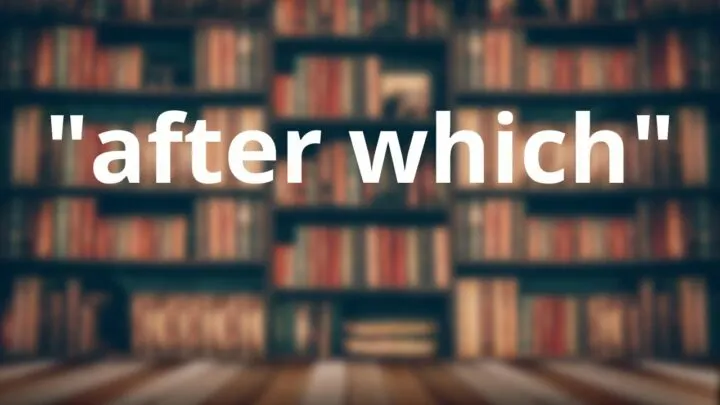“Which” is one of those tricky English words that can be used in a lot of different ways depending on where it appears in a sentence and what other words it is paired up with.
This means that it can even give native English speakers some problems!
One way you might see it used is paired with “after,” as in “after which.”
We’ll explain how to use “after which” with confidence in this article!
How is “after which” used in a sentence?
“After which” is used in a sentence to introduce a relative clause and to show that the actions described in that clause came after the actions in the preceding clause. Less commonly, it is used to talk about a thing being named after another thing.
What kind of phrase is “after which”?
Like “of which,” “after which” is a prepositional phrase.
However, unlike “of which,” which is used to describe or provide more information about something, “after which” is often used to describe an action.
“After which” can actually be used in two different ways, both to describe an action and to provide more information about the name of a thing.
“After which” to link actions
“After which” can link the actions at the beginning of the sentence to the actions that follow it.
“After which” means the same thing as “and then.”
You can also think of “after which” as a synonym for “afterwards” in this usage although the grammar is different. We’ll address that briefly later.
You can see how “after which” links one action or set of actions to the action that follows it in the sentence below:
They spent the day at the beach and then went to dinner after which Miriam said she was ready for dinner.
“After which” to show that a thing is named after another thing
“After which” can also be used to talk about the name of one thing being based on the name of another thing.
This is similar to the way “after whom” can be used, only “whom” is about people and not things.
If you were given the same name as your father, you would say that you are “named after” your father.
You could also say it like this:
My father, after whom I am named, often gets mail addressed to me.
Because this is a very specific usage of “after which”, you won’t see it as often as the other usage. However, it is a very common way to construct a sentene in which you are talking about the origins of a thing.
Here’s how you might see “after which” used in a sentence like that:
Champagne was a French province after which the sparkling wine is named.
How is “after which” used in a sentence?
It’s common to see the relative pronoun “which” paired with a preposition in a sentence, such as “in which” and “with which.” When that preposition changes, how “which” is used in the sentence changes as well.
Let’s take a look at some more examples of “after which” in a sentence.
As mentioned above, the most common usage is in showing that one action follows another:
And “after which” can also indicate the origin of a thing’s name:
“After which” as a synonym for “afterwards”
An easy way to understand the most common meaning and usage of “after which” is to think of it as a synonym for “afterwards.” However, there are grammatical differences.
“Afterwards” can come at the beginning of a stand-alone sentence.
“After which” cannot be at the beginning of a sentence. It would make the sentence into a fragment.
Here is an example of how they would appear differently in a sentence:
They went to the castle, after which it started raining, so they went home.
They went to the castle, but afterwards it started raining, so they went home.
In this example, both “after which” and “afterwards” emphasize the time relationship between the first clause and the second.
However, they are different parts of speech, which affects the clause that follows them.
“Afterwards” functions as a time adverbial, or an adverb that is about time.
It simply operates as an introductory phrase for the second independent clause.
Therefore, you need a conjunction (in this case “but”) to join the two sentences. A semicolon would also work.
If “after which” replaces “afterwards” in the sentence, that part of the sentence becomes a relative clause and not an independent clause.
A sentence beginning with “after which” cannot stand alone as a complete sentence and thus does not need a semicolon or a conjunction.

Hey fellow Linguaholics! It’s me, Marcel. I am the proud owner of linguaholic.com. Languages have always been my passion and I have studied Linguistics, Computational Linguistics and Sinology at the University of Zurich. It is my utmost pleasure to share with all of you guys what I know about languages and linguistics in general.

